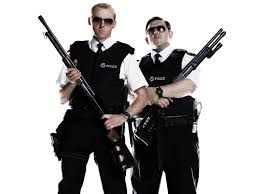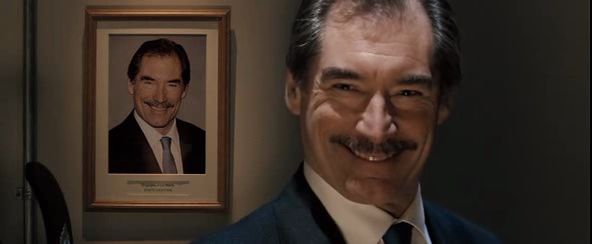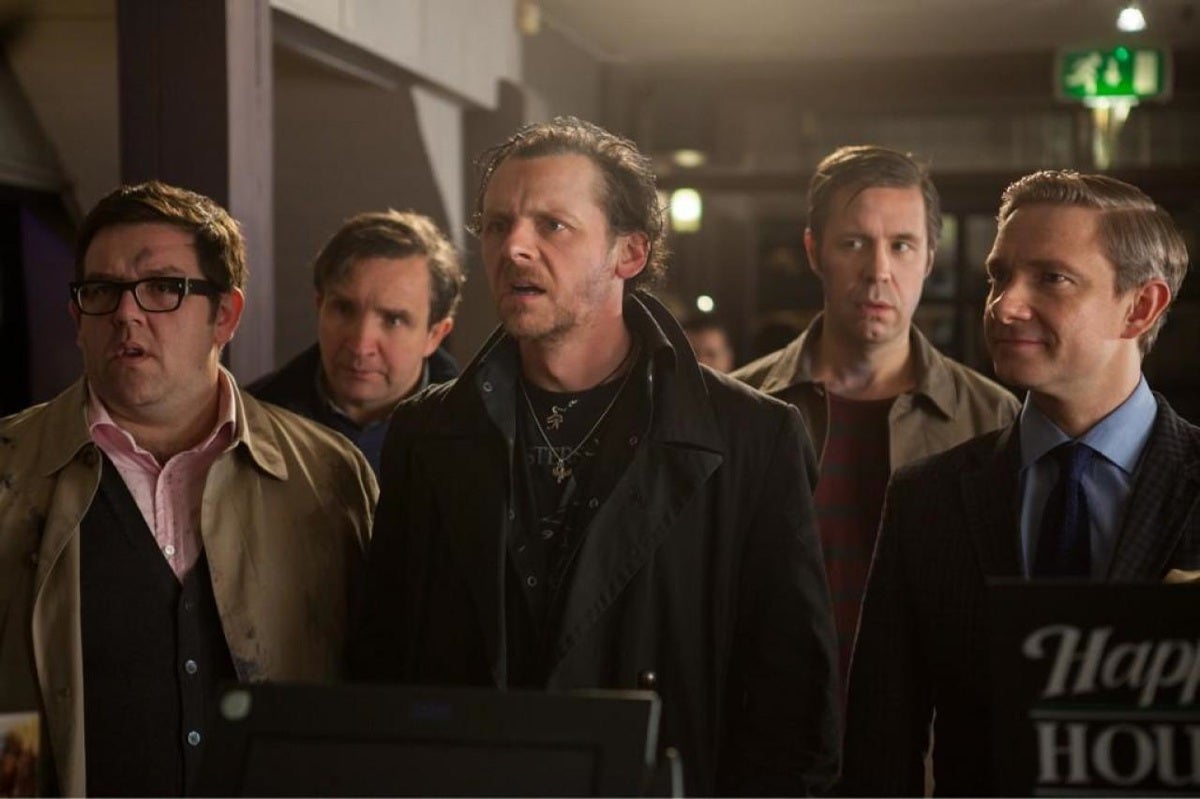Monday evening saw the Bay Area premiere of
The World's End, the final installment of what has been dubbed the Blood & Ice Cream (or Cornetto) Trilogy, by British director Edgar Wright and starring Simon Pegg and Nick Frost. Beginning with the cult favorite zombie comedy (zom-com?)
Shaun of the Dead in 2004, the team grew a strong following in the U.S. despite low theatrical earnings, and followed up with the equally under-appreciated spoof action film
Hot Fuzz in 2007. The trilogy will come to a close when
The World's End hits U.S. theatres August 23rd.
 |
| Tracie Chang's glorious poster designed just for Monday's event |
Thanks to San Francicso institution
MiDNiTES FOR MANiACS, now in its twelfth year, I was fortunate enough to attend a triple-feature screening of the trilogy in its entirety Monday, at the AMC Metreon. Watching the three films one after the other not only gave us lucky 200 audience members a chance to revisit everything we found brilliant about
Shaun of the Dead and
Hot Fuzz the first (and second, and third) time around, but it also underscored some of the thematic elements holding the trilogy together, and what I have come to see as Wright's overarching 'message.' Read on for my own attempt at a scholarly examination of the films, and a mini-review in which I will attempt to amp you up for the release of
The World's End without spoiling the big, secret twist! Here goes nothing...
 |
| A romantic comedy. With zombies. |
Every time I sit down to yet another viewing of Shaun of the Dead, I fall in love all over again in the first five minutes of the film. First, you're treated to a deliciously clever opening credit sequence, in which the masses of people on the streets of London go about their morning routines, effectively zombified by boredom and banality. Shortly thereafter comes a beautiful long shot that follows our hero all the way from his front door, down the block, to the corner market in one extended pan. The quick, frenetic camerawork throughout the film keeps you on your toes as things go from mundane to insane, and Shaun and his friends go head (or, rather, cricket bat) to head with the walking dead.
 |
| "I've got things I wanna do with my life!" |
Shaun of the Dead was conceived, filmed, and released when Wright, Pegg, and Frost were all in their late twenties to early thirties. Not only is it remarkable that a team of such relatively young filmmakers were able to create something so original with such lasting appeal, but the themes of the script really represent their particular stage of life at the time. Shaun, stuck in a thankless sales job amongst gum-smacking teenagers, is at a crossroads where he must decide who he wants to
be, in a larger sense, and his girlfriend Liz is there gently, then not-so-gently, urging him on. Only when the undead threaten the lives of his loved ones does Shaun find that the ability to step up and become a hero was always within him, and not only saves but also wins back the girl of his dreams.
 |
| When the heat is on, you gotta call the fuzz. |
Hot Fuzz brings Pegg and Frost back together on screen in yet another vignette of the life cycle of the average man. In this second installment, Pegg plays star police officer Nicholas Angel, who has a stellar arrest record, commendations coming out of his ears, and is set up for a nice promotion. He has put years of tireless effort into establishing himself in a career, and when he is transferred to a small, sleepy village in the countryside, he begins to see that he is missing the other aspects of a full and happy life. With the help of his bumbling partner, played by Frost, he works to uncover the truth behind a series of murders disguised as accidents, and in uncovering a vast Neighborhood Watch conspiracy, he finds it in himself to let go a little and toss the hard-and-fast rule of law aside in the name of what is right.
 |
| "My discounts are... criminal." |
It wouldn't be right to discuss
Hot Fuzz without a nod to some of the spectacular supporting performances by some really big British names. Jim Broadbent gets plenty of screen time as the benevolent but ultimately twisted Chief Inspector of the Sandford police, and as he loses his grip on sanity in the film's final scenes, he really steals the show. Timothy Dalton menaces from his first scenes as the sinister owner of the local
supermarché. And early in the film, Bill Nighy, Martin Freeman, and Steve Coogan all flit across the screen in a brief comedic turn as Angel's superiors.
 |
| Good food. Fine ales. Total annihilation. |
So having paid brilliantly clever homage to the horror genre, and then to the action-cop films of the eighties and nineties, what ground is left to be covered? Some readers will be thrilled to learn that Wright's latest, and the conclusion of the trilogy, runs in the vein of science fiction, playing on the clichés and tenets of alien classics like
Invasion of the Body Snatchers. But
The World's End is more than that - it's a film from the perspective of a writing team entering middle age, and beginning to look back on the accomplishments, mistakes, and missed opportunities of youth. Pegg's character, the antihero of our story, is
the Gary King, once the ringleader and Casanova of his pack of school chums. In the present day, he is a train wreck - he is unmarried, childless, by all evidence jobless, and struggling with substance abuse. In an attempt to reclaim the glory of the day he graduated from school, Gary reunites his four old friends (played by Nick Frost, Martin Freeman, Eddie Marsan, and Paddy Considine) and convinces them to grudgingly join him in completing a twelve-pub crawl through their hometown. But things aren't as they used to be in the town of Newton Haven, and the five soon find themselves not just fighting to reclaim their youth, but fighting for the future of the entire human race.

In the last film of this epic trilogy, Pegg and Frost both give truly spectacular performances, both in and outside of their respective comedic wheelhouses. There is a poignant sadness to Pegg's portrayal of the wayward Gary King as he puts on a brave front for his old friends, that reminded me strikingly of Richard E. Grant's performance in Bruce Robinson's 1987 cult classic
Withnail & I. (Of course, it could just be both characters' trademark trench coats.) And Frost is deadly serious as Gary's former best friend Andy, a complex relationship that is illuminated as the film moves forward. In the post-screening audience Q+A, Pegg described himself as a teen:
"I was a goth, I watched a lot of Sisters of Mercy videos. That was my thing when I was sixteen to eighteen. I wanted Gary to be like I was when I was sixteen, only trapped in amber."
When asked about some of the more trivial connections between the three films, Wright shed some light on his inspiration for
The World's End, as well as the overall them of the Cornetto Trilogy.
"Growing up in a small town, you start to imagine what's going on between closed doors. I think it made me more of a daydreamer. I can remember saying to my friends, 'every time I come back it feels like Bodysnatchers,' and there's a film in that!"
In my own view, which you may of course take with the proverbial grain of salt, all three films touch on some sort of "zombie" collectivism. In
Shaun of the Dead, the outbreak is literal, and our heroes struggle to retain their individuality rather than succumb to the zombie virus. In
Hot Fuzz, the danger is in a collective pursuing an ideology that has been twisted, perhaps a small-scale allegory for some of the political strife of the last several centuries. Sgt. Nicholas Angel must stand up for goodness when the easier choice might be to do nothing and let evil rule. And in
The World's End, fucked up Gary King makes one last stand for the uniqueness of every human that makes our race beautiful, and resists joining the collective Network of dull perfection.
Wright elaborated on this homogenizing of human life:
"When we made Hot Fuzz
, which was shot in my hometown, when Nicholas Angel is riding down the high street on a horse, I had to digitally erase a Starbucks. It's like the high street virus has spread everywhere, and everything's the same."
The World's End will make you laugh, cheer, and maybe even cry, and if you're anything like me, some of the themes will resonate with you long after you've left the theatre. Again, the film hits U.S. theatres August 23rd, and it's going to be a hell of a lot more bang for your buck than a certain Seth Rogen film of a similar title... Trust me.





.jpg)









